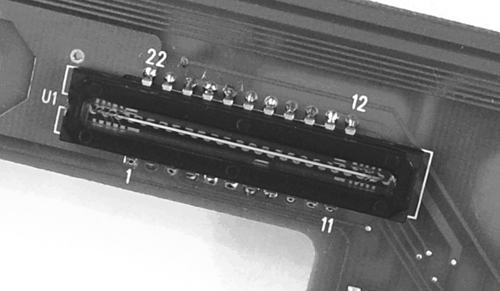Line-Scan Cameras
In Figure 2.14 we showed a one-dimensional CCD array for measuring positions or lengths of objects. In general, we can use the same sensor to acquire two-dimensional images; we only have to scan the second dimension. There are two principal ways to do this:
- The sensor moves relative to the object to be scanned; this principle is used in flat-bed image scanners , whereby two-dimensional images (mostly on paper) can be transferred into digital media.
- The object moves relative to the sensor; at first glance, there seems to be no difference from the first possibility, but some differences do exist:
- Normally, objects can be moved quickly and easily. If a large number of objects had to be scanned, it would obviously take more time and effort to position the camera rather than to simply position the objects.
- The object is not limited regarding its length. Figure 2.18 shows an example in which a one-dollar note is being scanned. It is easy to imagine that it would be no problem to add a number of dollar notes to a single image.
Figure 2.18. Principle of a Line-Scan Camera

With this technology, one can easily generate images with a large number of pixels. For example, the sensor of the line-scan camera in Figure 2.18 has 2048 pixels, which means that it is a high-resolution type. Imagine further that the resolution in both directions should be the same, resulting in a total resolution of about 2048 x 4800  9.8 million pixels ”and that with a simple sensor of 2048 CCD cells .
9.8 million pixels ”and that with a simple sensor of 2048 CCD cells .
The main application area for line-scan cameras is product inspection; in particular, products transported by a conveyor belt or rotating cylindrical objects are easy to scan. Figure 2.19 shows a line-scan sensor for those or similar applications.
Figure 2.19. Line-Scan Sensor Used in a Flat-Bed Scanner

CMOS Image Sensors |
Introduction and Definitions
- Introduction
- Some Definitions
- Introduction to IMAQ Vision Builder
- NI Vision Builder for Automated Inspection
Image Acquisition
- Image Acquisition
- Charge-Coupled Devices
- Line-Scan Cameras
- CMOS Image Sensors
- Video Standards
- Color Images
- Other Image Sources
Image Distribution
- Image Distribution
- Frame Grabbing
- Camera Interfaces and Protocols
- Compression Techniques
- Image Standards
- Digital Imaging and Communication in Medicine (DICOM)
Image Processing
Image Analysis
- Image Analysis
- Pixel Value Analysis
- Quantitative Analysis
- Shape Matching
- Pattern Matching
- Reading Instrument Displays
- Character Recognition
- Image Focus Quality
- Application Examples
About the CD-ROM
EAN: 2147483647
Pages: 55
